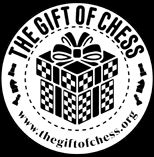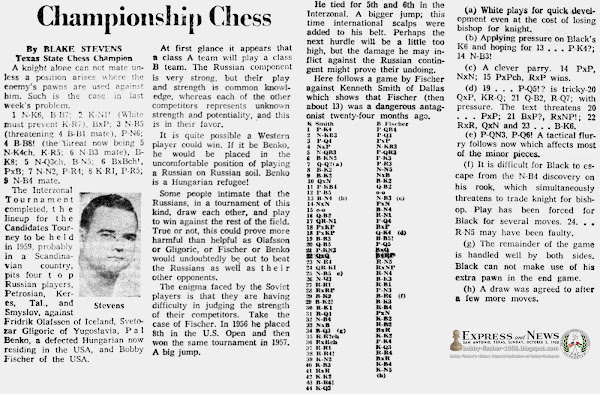San Antonio Express, San Antonio, Texas, Sunday, October 05, 1958
The Interzonal Tournament completed, the lineup for the Candidates Tourney to be held in 1959, probably in a Scandinavian country, pits four top Russian players, Petrosian, Keres, Tal, and Smyslov, against Fridrik Olafsson of Iceland, Svetozar Gligoric of Yugoslavia, Pal Benko, a defected Hungarian now residing in the USA, and Bobby Fischer of the USA.
At first glance it appears that a class A team will play a class B team. The Russian component is very strong, but their play and strength is common knowledge, whereas each of the other competitors represents unknown strength and potentiality, and this is in their favor.
It is quite possible a Western player could win. If it be Benko, he would be placed in the uncomfortable position of playing a Russian on Russian soil. Benko is a Hungarian refugee!
Some people intimate that the Russians, in a tournament of this kind, draw each other, and play to win against the rest of the field. True or not, this could prove more harmful than helpful as Olafsson or Gligoric, or Fischer or Benko would undoubtedly be out to beat the Russians as well as their other opponents.
The enigma faced by the Soviet players is that they are having difficulty in judging the strength of their competitors. Take the case of Fischer. In 1956 he placed 8th in the U.S. Open and then won the same tournament in 1957. A big jump. He tied for 5th and 6th in the Interzonal. A bigger jump; this time international scalps were added to his belt. Perhaps the next hurdle will be a little too high, but the damage he may inflict against the Russian contingent might prove their undoing.
Here follows a game by Fischer against Kenneth Smith of Dallas which shows that Fischer (then about 13) was a dangerous antagonist twenty-four months ago.
Kenneth Smith vs Robert James Fischer
57th US Open (1956), Oklahoma City, OK USA, rd 7, Jul-23
Sicilian Defense: Najdorf Variation (B95) 1/2-1/2
(a) White plays for quick development event at the cost of losing bishop for knight.
(b) Applying pressure on Black's K6 and hoping for 13 … P-K4?; 14. N-B3!
(c) A clever parry. 14. PxP, NxN; 15. PxPch, RxP wins.
(d) 19…P-Q5!? is tricky - 20. QxP, KR-Q; 21 Q-B2; R-Q7; with pressure. The text threatens 20 … PxP; 21 BxP?, RxNP!; 22. RxR, QxN and 23 … B-K6.
(e) P-QN3, P-Q6! A tactical flurry follows now which affects most of the minor pieces.
(f) It is difficult for Black to escape from the N-B4 discovery on his rook, which simultaneously threatens to trade knight for bishop. Play has been forced for Black for several moves. 24…R-N5 may have been faulty.
(g) The remainder of the game is handled well by both sides. Black can not make use of his extra pawn in the end game.
(h) A draw was agreed to after a few more moves.
























